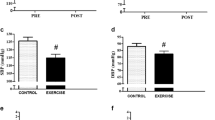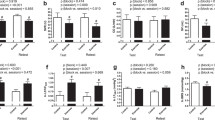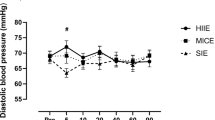Abstract
Post exercise hypotension (PEH) is a phenomenon of a prolonged decrease in resting blood pressure in the minutes and hours following acute exercise. Knowledge of PEH is potentially useful in designing first line strategies against hypertension as well as allowing a further understanding of blood pressure regulation in both health and disease. Following a brief review of blood pressure responses to exercise, this paper will provide a current and comprehensive summary of PEH and integrate the current state of knowledge surrounding it.
This is a preview of subscription content, access via your institution
Access options
Subscribe to this journal
Receive 12 digital issues and online access to articles
$119.00 per year
only $9.92 per issue
Buy this article
- Purchase on Springer Link
- Instant access to full article PDF
Prices may be subject to local taxes which are calculated during checkout

Similar content being viewed by others
References
MacDougall JD, Reddan WG, Layton CR, Dempsey JA . Effects of metabolic hyperthermia on performance during heavy prolonged exercise J Appl Physiol 1974 36: 538–544
MacDougall JD . Blood pressure responses to resistive, static and dynamic exercise In: Fletcher GF (ed) Futura Publishing: Kisco, NY 1994 pp 155–173
Palatini P . Exercise haemodynamics in the normotensive and the hypertensive subject Clin Sci (Colch) 1994 87: 275–287
MacDougall JD, Tuxen D, Sale DG, Moroz JR, Sutton JR . Arterial blood pressure response to heavy resistance exercise J Appl Physiol 1985 58: 785–790
Lentini AC et al. Left ventricular response in healthy young men during heavy-intensity weight-lifting exercise J Appl Physiol 1993 75: 2703–2710
Seals DR, Hagberg JM . The effect of exercise training on human hypertension: a review Med Sci Sports Exerc 1984 16: 207–215
Tipton CM . Exercise, training, and hypertension Exerc Sport Sci Rev 1984 12: 245–306
Hill L . Arterial pressure in man while sleeping, resting, working and bathing J Physiol Lond 1897 22: xxvi–xxix
Fitzgerald W . Labile hypertension and jogging: new diagnostic tool or spurious discovery? Br Med J (Clin Res Ed) 1981 282: 542–544
Floras JS et al. Postexercise hypotension and sympathoinhibition in borderline hypertensive men Hypertension 1989 14: 28–35
Somers VK, Conway J, LeWinter M, Sleight P . The role of baroreflex sensitivity in post-exercise hypotension J Hypertens Suppl 1985 Suppl 3: S129–S130
MacDonald JR, MacDougal JD, Hogben CD . The effects of exercise duration on post-exercise hypotension J Hum Hypertens 2000 14: 125–129
Hagberg JM, Montain SJ, Martin WH 3rd . Blood pressure and hemodynamic responses after exercise in older hypertensives J Appl Physiol 1987 63: 270–276
Wilcox RG et al. Post-exercise hypotension: the effects of epanolol or atenolol on some hormonal and cardiovascular variables in hypertensive men Br J Clin Pharmacol 1987 24: 151–162
Rueckert PA, Slane PR, Lillis DL, Hanson P . Hemodynamic patterns and duration of post-dynamic exercise hypotension in hypertensive humans Med Sci Sports Exerc 1996 28: 24–32
MacDonald JR et al. Hypotension following mild bouts of resistance exercise and submaximal dynamic exercise Eur J Appl Physiol Occup Physiol 1999 79: 148–154
Hayward CS, Kelly RP . Gender-related differences in the central arterial pressure waveform J Am Coll Cardiol 1997 30: 1863–1871
Matsukawa T et al. Gender difference in age-related changes in muscle sympathetic nerve activity in healthy subjects Am J Physiol 1998 275: R1600–R1604
Paulev PE, Jordal R, Kristensen O, Ladefoged J . Therapeutic effect of exercise on hypertension Eur J Appl Physiol Occup Physiol 1984 53: 180–185
Headley SA, Claiborne JM, Lottes CR, Korba CG . Hemodynamic responses associated with post-exercise hypotension in normotensive black males Ethn Dis 1996–1997 6: 190–201
Raglin JS, Turner PE, Eksten F . State anxiety and blood pressure following 30 min of leg ergometry or weight training Med Sci Sports Exerc 1993 25: 1044–1048
Coats AJ . Systemic and forearm vascular resistance changes after upright bicycle exercise in man J Physiol 1989 413: 289–298
Brown SP, Clemons JM, He Q, Liu S . Effects of resistance exercise and cycling on recovery blood pressure J Sports Sci 1994 12: 463–468
Southard DR, Hart L . The influence on blood pressure during daily activities of a single session of aerobic exercise Behav Med 1991 17: 135–142
Kaufman FL, Hughson RL, Schaman JP . Effect of exercise on recovery blood pressure in normotensive and hypertensive subjects Med Sci Sports Exerc 1987 19: 17–20
Yao T, Andersson S, Thoren P . Long-lasting cardiovascular depression induced by acupuncture-like stimulation of the sciatic nerve in unanaesthetized spontaneously hypertensive rats Brain Res 1982 240: 77–85
Chandler MP, DiCarlo SE . Sinoaortic denervation prevents postexercise reductions in arterial pressure and cardiac sympathetic tonus Am J Physiol 1997 273: H2738–H2745
Chen Y, Chandler MP, DiCarlo SE . Acute exercise attenuates cardiac autonomic regulation in hypertensive rats Hypertension 1995 26: 676–683
Kenney MJ, Morgan DA, Mark AL . Sympathetic nerve responses to sustained stimulation of somatic afferents in Dahl rats J Hypertens 1991 9: 963–968
Hoffmann P, Thoren P . Long-lasting cardiovascular depression induced by acupuncture-like stimulation of the sciatic nerve in unanaesthetized rats. Effects of arousal and type of hypertension Acta Physiol Scand 1986 127: 119–126
Franklin PJ, Green DJ, Cable NT . The influence of thermoregulatory mechanisms on post-exercise hypotension in humans J Physiol 1993 470: 231–241
Boone JB Jr et al. Opioid receptor modulation of postexercise hypotension Med Sci Sports Exerc 1992 24: 1108–1113
Piepoli M et al. Persistent peripheral vasodilation and sympathetic activity in hypotension after maximal exercise J Appl Physiol 1993 75: 1807–1814
Hara K, Floras JS . Influence of naloxone on muscle sympathetic nerve activity, systemic and calf haemodynamics and ambulatory blood pressure after exercise in mild essential hypertension J Hypertens 1995 13: 447–461
Isea JE et al. Time course of haemodynamic changes after maximal exercise Eur J Clin Invest 1994 24: 824–829
MacDonald J, MacDougall J, Hogben C . The effects of exercise intensity on post exercise hypotension J Hum Hypertens 1999 13: 527–531
MacDonald JR, MacDougall JD, Hogben CD . The effects of exercising muscle mass on post exercise hypotension J Hum Hypertens 2000 14: 317–320
MacDonald JR, Hogben CD, Tarnopolsky MA, MacDougall JD . Post exercise hypotension is sustained during mild exercise and simulated activites of daily living J Hum Hypertens 2001 15: 567–572
MacDonald et al. Post exercise hypotension is not mediated by the serotonergic system in borderline hypertensive individuals J Hum Hypertens 2002 16: 33–39
Wallace JP et al. The magnitude and duration of ambulatory blood pressure reduction following acute exercise J Hum Hypertens 1999 13: 361–366
Brownley KA, West SG, Hinderliter AL, Light KC . Acute aerobic exercise reduces ambulatory blood pressure in borderline hypertensive men and women Am J Hypertens 1996 9: 200–206
Cleroux J et al. Baroreflex regulation of forearm vascular resistance after exercise in hypertensive and normotensive humans Am J Physiol 1992 263: H1523–H1531
Cleroux J et al. Aftereffects of exercise on regional and systemic hemodynamics in hypertension Hypertension 1992 19: 183–191
Pescatello LS, Fargo AE, Leach CN Jr, Scherzer HH . Short-term effect of dynamic exercise on arterial blood pressure Circulation 1991 83: 1557–1561
Hannum SM, Kasch FW . Acute postexercise blood pressure response of hypertensive and normotensive men Scandi J Sports Scie 1981 3: 11–15
Yao T, Andersson S, Thoren P . Long-lasting cardiovascular depressor response following sciatic stimulation in spontaneously hypertensive rats. Evidence for the involvement of central endorphin and serotonin systems Brain Res 1982 244: 295–303
Silva GJ, Brum PC, Negrao CE, Krieger EM . Acute and chronic effects of exercise on baroreflexes in spontaneously hypertensive rats Hypertension 1997 30: 714–719
VanNess JM, Takata HJ, Overton JM . Attenuated blood pressure responsiveness during post-exercise hypotension Clin Exp Hypertens 1996 18: 891–900
Overton JM, Joyner MJ, Tipton CM . Reductions in blood pressure after acute exercise by hypertensive rats J Appl Physiol 1988 64: 748–752
Kulics JM, Collins HL, DiCarlo SE . Postexercise hypotension is mediated by reductions in sympathetic nerve activity Am J Physiol 1999 276: H27–H32
Collins HL, DiCarlo SE . Attenuation of postexertional hypotension by cardiac afferent blockade Am J Physiol 1993 265: H1179–H1183
Hoffmann P, Delle M, Thoren P . Role of opioid receptors in the long-lasting blood pressure depression after electric muscle stimulation in the hind leg of the rat Acta Physiol Scand 1990 140: 191–198
Hoffmann P, Carlsson S, Skarphedinsson JO, Thoren P . Role of different serotonergic receptors in the long-lasting blood pressure depression following muscle stimulation in the spontaneously hypertensive rat Acta Physiol Scand 1990 139: 305–310
Hoffmann P, Thoren P . Electric muscle stimulation in the hind leg of the spontaneously hypertensive rat induces a long-lasting fall in blood pressure Acta Physiol Scand 1988 133: 211–219
Wilcox RG, Bennett T, Brown AM, Macdonald IA . Is exercise good for high blood pressure? Br Med J (Clin Res Ed) 1982 285: 767–769
Wallace JP et al. A comparison of 24-h average blood pressures and blood pressure load following exercise Am J Hypertens 1997 10: 728–734
Floras JS, Wesche J . Haemodynamic contributions to post-exercise hypotension in young adults with hypertension and rapid resting heart rates J Hum Hypertens 1992 6: 265–269
Hara K, Floras JS . Effects of naloxone on hemodynamics and sympathetic activity after exercise J Appl Physiol 1992 73: 2028–2035
Halliwill JR, Taylor JA, Eckberg DL . Impaired sympathetic vascular regulation in humans after acute dynamic exercise J Physiol 1996 495: 279–288
Landry JF . A study of some potential correlates of the hypotensive effects of prolonged submaximal exercise in normotensive men Can J Physiol Pharmacol 1992 70: 53–59
Somers VK et al. Postexercise hypotension is not sustained in normal and hypertensive humans Hypertension 1991 18: 211–215
Forjaz CL et al. Post-exercise changes in blood pressure, heart rate and rate pressure product at different exercise intensities in normotensive humans Brazi J Medi Biolog Res 1998 31: 1247–1255
Halliwill JR, Taylor JA, Hartwig TD, Eckberg DL . Augmented baroreflex heart rate gain after moderate-intensity, dynamic exercise Am J Physiol 1996 270: R420–R426
Hill DW, Butler SD . Haemodynamic responses to weightlifting exercise Sports Med 1991 12: 1–7
Boer NF, Brown MD, Zimet RJ, Hagberg JM . The effect of a singe bout of weight training on ambulatory blood pressure. 18th Annual Meeting: Mid-Atlantic Region Chapter of the American College of Sports Medicine Proceedings 1995
O'Connor PJ, Bryant CX, Veltri JP, Gebhardt SM . State anxiety and ambulatory blood pressure following resistance exercise in females Med Sci Sports Exerc 1993 25: 516–521
Shyu BC, Thoren P . Circulatory events following spontaneous muscle exercise in normotensive and hypertensive rats Acta Physiol Scand 1986 128: 515–524
Boone JB Jr, Corry JM . Proenkephalin gene expression in the brainstem regulates post-exercise hypotension Brain Res Mol Brain Res 1996 42: 31–38
Shyu BC, Andersson SA, Thoren P . Circulatory depression following low frequency stimulation of the sciatic nerve in anesthetized rats Acta Physiol Scand 1984 121: 97–102
Yao T, Andersson S, Thoren P . Long-lasting cardiovascular depressor response to somatic stimulation in spontaneously hypertensive rats Acta Physiol Scand 1981 111: 109–111
Halliwill JR, Minson CT, Joyner MJ . Effect of systemic nitric oxide synthase inhibition on postexercise hypotension in humans J Appl Physiol 2000 89: 1830–1836
Piepoli M et al. Load dependence of changes in forearm and peripheral vascular resistance after acute leg exercise in man J Physiol 1994 478: 357–362
Bennett T, Wilcox RG, MacDonald IA . Post-exercise reduction of blood pressure in hypertensive men is not due to acute impairment of baroreflex function Clin Sci (Colch) 1984 67: 97–103
Seals DR et al. Left ventricular dysfunction after prolonged strenuous exercise in healthy subjects Am J Cardiol 1988 61: 875–879
Hara K, Floras JS . After-effects of exercise on haemodynamics and muscle sympathetic nerve activity in youngpatients with dilated cardiomyopathy Heart 1996 75: 602–608
Floras JS, Senn BL . Absence of post exercise hypotension and sympathoinhibition in normal subjects: additional evidence for increased sympathetic outflow in borderline hypertension Can J Cardiol 1991 7: 253–258
West SG, Brownley KA, Light KC . Postexercise vasodilatation reduces diastolic blood pressure responses to stress Ann Behav Med 1998 20: 77–83
Forjaz CL et al. Effect of exercise duration on the magnitude and duration of post-exercise hypotension Arq Bras Cardiol 1998 70: 99–104
Boone JB Jr, Probst MM, Rogers MW, Berger R . Postexercise hypotension reduces cardiovascular responses to stress J Hypertens 1993 11: 449–453
Kriemler S et al. Impact of a single exercise bout on energy expenditure and spontaneous physical activity of obese boys Pediatr Res 1999 46: 40–44
Kenney MJ, Morgan DA . Sciatic nerve stimulation induces hypotension but not renal or lumbar sympathoinhibition in hypertensive Dahl rats Clin Auton Res 1993 3: 163–168
Mitchell JH . Cardiovascular control during exercise: central and reflex neural mechanisms Am J Cardiol 1985 55: 34D–41D
Guyton AC . Arterial Pressure and Hypertension. W.B Saunders: Toronto 1980
Grassi G . Role of the sympathetic nervous system in human hypertension J Hypertens 1998 16: 1979–1987
Perrault H et al. Plasma atrial natriuretic peptide during brief upright and supine exercise in humans J Appl Physiol 1989 66: 2159–2167
Davis AL . Atrial natriuretic factor Adv Pediatr 1989 36: 137–150
Guyton AC, Hall JE . Textbook of Medical Physiology. W.B Saunders; Philadelphia 1996
Medbo JI, Sejersted OM . Plasma potassium changes with high intensity exercise J Physiol 1990 421: 105–122
Hallen J, Gullestad L, Sejersted OM . K+ shifts of skeletal muscle during stepwise bicycle exercise with and without beta-adrenoceptor blockade J Physiol 1994 477: 149–159
Sparks HV . Mechanism of vasodilation during and after ischemic exercise Fed Proc 1980 39: 1487–1490
Ward ME . Dilation of rat diaphragmatic arterioles by flow and hypoxia: roles of nitric oxide and prostaglandins J Appl Physiol 1999 86: 1644–1650
Wilson JR, Kapoor SC . Contribution of prostaglandins to exercise-induced vasodilation in humans Am J Physiol 1993 265: H171–H175
Morganroth ML, Young EW, Sparks HV . Prostaglandin and histaminergic mediation of prolonged vasodilation after exercise Am J Physiol 1977 233: H27–H33
Howard MG, DiCarlo SE . Reduced vascular responsiveness after a single bout of dynamic exercise in the conscious rabbit J Appl Physiol 1992 73: 2662–2667
Patil RD, DiCarlo SE, Collins HL . Acute exercise enhances nitric oxide modulation of vascular response to phenylephrine Am J Physiol 1993 265: H1184–H1188
Janal MN, Colt EW, Clark WC, Glusman M . Pain sensitivity, mood and plasma endocrine levels in man following long-distance running: effects of naloxone Pain 1984 19: 13–25
Lemaire I, Tseng R, Lemaire S . Systemic administration of beta-endorphin: potent hypotensive effect involving a serotonergic pathway Proc Natl Acad Sci USA 1978 75: 6240–6242
Asmundsson G et al. Extracellular serotonin changes in VLM during muscle contraction: effects of 5-HT1A-receptor activation Am J Physiol 1997 273: H2899–H2909
Steinberg LL et al. Serum level of serotonin during rest and during exercise in paraplegicpatients Spinal Cord 1998 36: 18–20
Author information
Authors and Affiliations
Corresponding author
Rights and permissions
About this article
Cite this article
MacDonald, J. Potential causes, mechanisms, and implications of post exercise hypotension. J Hum Hypertens 16, 225–236 (2002). https://doi.org/10.1038/sj.jhh.1001377
Published:
Issue Date:
DOI: https://doi.org/10.1038/sj.jhh.1001377
Keywords
This article is cited by
-
An evidence-based guide to the efficacy and safety of isometric resistance training in hypertension and clinical implications
Clinical Hypertension (2023)
-
Effect of exercise training on the renin–angiotensin–aldosterone system: a meta–analysis
Journal of Human Hypertension (2023)
-
Increasing pulse pressure ex vivo, mimicking acute physical exercise, induces smooth muscle cell-mediated de-stiffening of murine aortic segments
Communications Biology (2023)
-
Do Sports Compression Garments Alter Measures of Peripheral Blood Flow? A Systematic Review with Meta-Analysis
Sports Medicine (2023)
-
Calf Venous Compliance During Hypotension After an Acute bout of Aerobic Exercise in Humans
Journal of Science in Sport and Exercise (2023)



